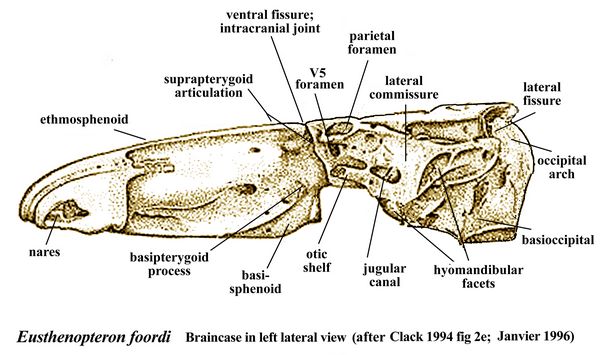Athena Review Image Archive ™
Eusthenopteron fordii skull

Braincase of Eusthenopteron fordii (after Clack 1994 and Janvier 1996).
Eusthenopteron
fordii is a species of sarcopterygian (lobe-finned) fishes dating from the Late Devonian period (385 mya), with a close
relationship to tetrapods. It is in the class
Sarcoptergerii, the subclass Tetrapodomorpha, the superorder Osteolepidida, and the family Tristichopteridae.
Eusthenopteron was first described by J. F. Whiteaves in 1881 as part of a large collection of fishes from Miguasha, Quebec. These were studied between the1940s and 1990s by paleoichthyologist Erik Jarvik, focusing on their close linkage to early tetrapods.
Eusthenopteron shares many unique features with the earliest known tetrapods. It has a similar pattern of skull roofing bones with Ichthyostega and Acanthostega. Like other fish-like sarcopterygians, Eusthenopteron possessed a two-part cranium, which hinged at mid-length along an intracranial joint (shown in figure). It also had internal nostrils (or a choana); which are found only in land animals and sarcopterygians.
The reptilian
stapes or middle ear ossicle seems to have evolved from the hyomandibular bone of
sacropterygians like Eusthenopteron, which has prominent hyomandibular
facets (shown at right in the figure). Differing morphology of the stapes vs. the hyomandibular relates
to the orbital (stapedial) artery.
References:
Clack 1994
Janvier 1996
Jarvik 1980
Smithson, T.R. and K.S. Thompson 1982 The hyomandibular of Eusthenopteron foordi Whiteaves (Pisces: Crossopterygii) and the early evolution of the tetrapod stapes.
.
Copyright © 1996-2020 Rust Family Foundation (All Rights Reserved).